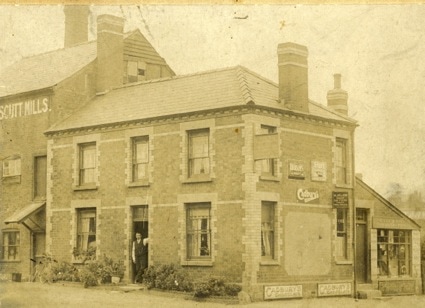9) Scutt Mill
The Yazor Brook, which, possibly, marks an earlier course of the river Wye, rises at Foxley in Mansell Lacy, entering the city close to the cattle market on Roman Road, and is variously known as the Canny, Tan, Widemarsh, Scutt, Ayls and Eign brooks.
This was the power source for many city mills including Scuts or ‘Scutt’ Mill, opposite, to the left of the fuel station. The Yazor Brook supported at least three other mills, one near Prior Street, another used for corn and later tanning at Monkmoor on the site of Morrisons supermarket, and lower down on Eign Mill Road.
Scutt Mill was probably the Tupsley parish mill mentioned in the Domesday Book, and, with annual rent of 50s in the 13C, was a valuable resource; the word “Scutt” is either derived from “scytte”, the Old English for weir, or more probably “scutting” which is the process of crushing flax fibre for linen making. Flax was grown and processed in Herefordshire, but by 1700 Hereford City restricted the dressing and dying of flax and hemp within the walls of the city, probably due to pollution. It’s likely the mill was converted from a flax mill to a corn mill around this time. In 1877 the mill was sold as a water corn mill with two pairs of stones, but by 1888 it had switched to steam power. The mill pond disappeared around then and the neighbouring building, with the recently refurbished wall sign, once a bakery, suggests the mill was used for fine flour milling (for buns and cakes) as well as coarser baking flour. Scutts was run by Saunders and Co until 1910 and by 1913 it had been turned into William Jay’s builder’s yard. By 1933 the shop was run by William Marsh, later to be taken over by Mr and Mrs Badman. The mill was demolished in 1985.
The Yazor Brook, which, possibly, marks an earlier course of the river Wye, rises at Foxley in Mansell Lacy, entering the city close to the cattle market on Roman Road, and is variously known as the Canny, Tan, Widemarsh, Scutt, Ayls and Eign brooks.
This was the power source for many city mills including Scuts or ‘Scutt’ Mill, opposite, to the left of the fuel station. The Yazor Brook supported at least three other mills, one near Prior Street, another used for corn and later tanning at Monkmoor on the site of Morrisons supermarket, and lower down on Eign Mill Road.
Scutt Mill was probably the Tupsley parish mill mentioned in the Domesday Book, and, with annual rent of 50s in the 13C, was a valuable resource; the word “Scutt” is either derived from “scytte”, the Old English for weir, or more probably “scutting” which is the process of crushing flax fibre for linen making. Flax was grown and processed in Herefordshire, but by 1700 Hereford City restricted the dressing and dying of flax and hemp within the walls of the city, probably due to pollution. It’s likely the mill was converted from a flax mill to a corn mill around this time. In 1877 the mill was sold as a water corn mill with two pairs of stones, but by 1888 it had switched to steam power. The mill pond disappeared around then and the neighbouring building, with the recently refurbished wall sign, once a bakery, suggests the mill was used for fine flour milling (for buns and cakes) as well as coarser baking flour. Scutts was run by Saunders and Co until 1910 and by 1913 it had been turned into William Jay’s builder’s yard. By 1933 the shop was run by William Marsh, later to be taken over by Mr and Mrs Badman. The mill was demolished in 1985.


